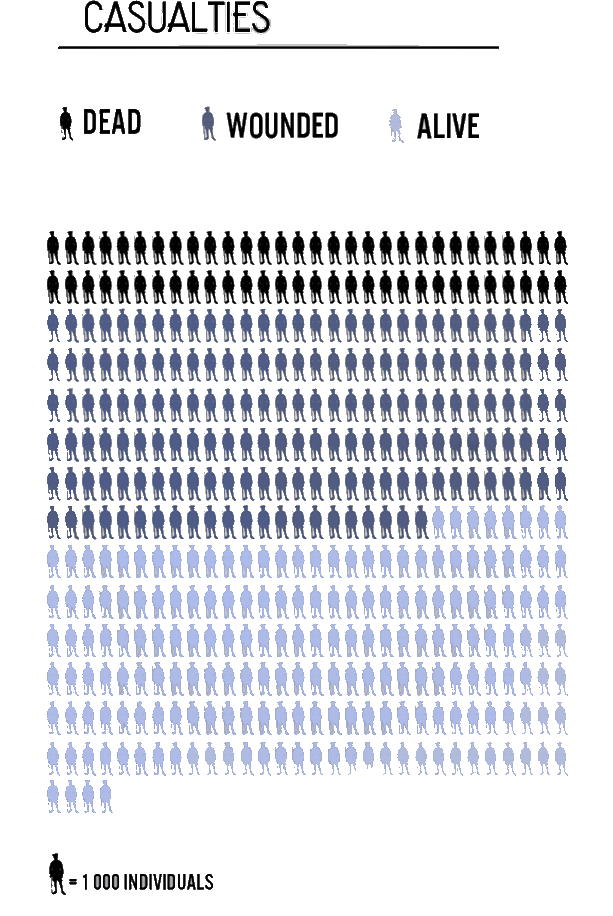The Cost of Victory
50% casualty rate for Canadians deployed overseas
Canadian troops quickly earned a reputation for being strong, brave – and effective. Soon, they were used by the Allies as “shock troops”, which meant that they were sent to where the battle had stagnated in order to offer reinforcement and hopefully break through the enemy lines.
As a consequence, the Canadian Corps sustained a high number of casualties. Of the 619,636 Canadians who enlisted, 424,000 served abroad. From those 424 000 soldiers, 59,544 died during the war and another 172,000 were wounded.
While it is easy to find out how many soldiers were physically hurt by the war, it is much harder to find what psychological impact the war had on soldiers. Some 9,000 Canadian soldiers were reported as suffering from “shell shock”, which we refer to today as post-traumatic stress disorder (PTSD).

A Regiment’s most sacred distinguishing honour
The Regimental Colour is embroidered and carefully woven by skilled craftsmen and can only be approved by the reigning Monarch. The Royal Montreal Regiment has received their first set of colours in January 1919 at Unter Eschbach, Germany. This was the first time that a Regiment had been presented with Colours on foreign conquered soil at the end of a victorious campaign.
A Symbolic Memorial Plaque
The Memorial Plaque was issued during WW1 and was given to the next of kin of all servicemen and servicewomen of the British Empire who died during the Great War. 1,355,000 bronze memorial plaques were issued throughout the British Empire. Popularly known as “Dead Man’s Penny” because of it’s shape and colour. Each memorial plaque was personalized with the name of the individual killed, along with the inscription “He died for freedom and honour” (the memorial plaques were modified for females to read “She died…”)
Each element in the design by Edward Carter Preston carries its own significance.
Additional resources
Documentation
National World War I Museum and Memorial
https://www.theworldwar.org/explore/interactive-wwi-timeline
Vimy in Colour
http://www.vimyfoundation.ca/learn/ww1-colourization-project/
Example from The Canadian Letters and Images Project: WWI
http://www.canadianletters.ca/content/document-12949
Christmas card
http://www.canadianletters.ca/content/document-12698
On Remembrance Day
https://www.thecanadianencyclopedia.ca/en/article/remembrance-day/
To organize a ceremony of Remembrance Day in your own school, if one does not already exist, use this link from Veterans Affairs to help you
http://www.veterans.gc.ca/eng/remembrance/get-involved/remembrance-day/guide-to-commemorative-services
Large Canadian war memorials:
Memorials in Canada
http://www.veterans.gc.ca/eng/remembrance/memorials/canada
Unknown soldier, Ottawa
http://www.warmuseum.ca/firstworldwar/history/after-the-war/remembrance/the-unknown-soldier/
Experience Vimy – Veterans Affairs
http://www.veterans.gc.ca/eng/remembrance/memorials/overseas/first-world-war/france/vimy/experience-vimy
Canadian Virtual War Memorial
http://www.veterans.gc.ca/eng/remembrance/memorials/canadian-virtual-war-memorial
Multimedia material
Graphic illustration of voter rights 1917
http://www.cpac.ca/en/1917-blood-on-the-ballot/
and
http://www.cpac.ca/en/1917-swaying-the-public/
(A selection of Unionist and Laurier Liberal material from 1917 election, great resource).
NFB doc: Front Lines: The Trenches. Excerpts of letters home are read describing soldier life in the trenches. 9:45 mins.
https://www.nfb.ca/film/front-lines-the-trenches/
